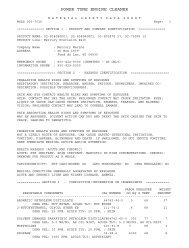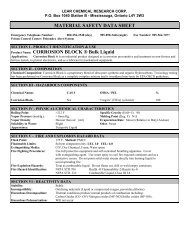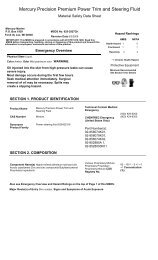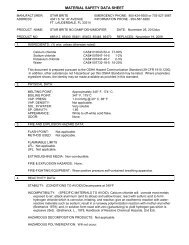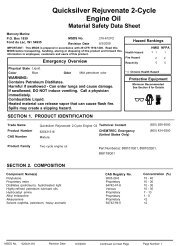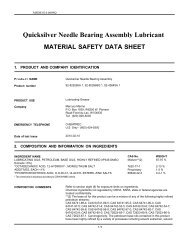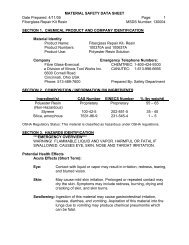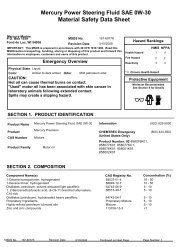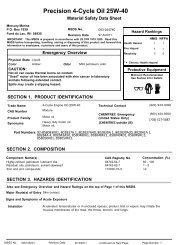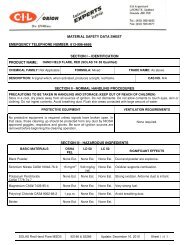Mercury Quicksilver Premium Power Trim and ... - Mercury Marine
Mercury Quicksilver Premium Power Trim and ... - Mercury Marine
Mercury Quicksilver Premium Power Trim and ... - Mercury Marine
You also want an ePaper? Increase the reach of your titles
YUMPU automatically turns print PDFs into web optimized ePapers that Google loves.
established occupational exposure level (See Section 8). Promptly remove contaminated<br />
clothing. Wash exposed skin thoroughly with soap <strong>and</strong> water after h<strong>and</strong>ling.<br />
Do not pressurize, cut, weld, braze solder, drill, grind or expose containers to flames, sparks, heat<br />
or other potential ignition sources. Protect containers against physical damage. Consult<br />
appropriate federal, state <strong>and</strong> local authorities before reusing, reconditioning, reclaiming,<br />
recycling or disposing of empty containers <strong>and</strong>/or waste residues of this product.<br />
Storage Keep container tightly closed. Store in a cool, dry, well-ventilated area. Store only in approved containers. Do<br />
not store with strong oxidizing agents. Do not store at elevated temperatures. Avoid storing product in direct sunlight for<br />
extended periods of time. Storage area must meet OSHA requirements <strong>and</strong> applicable fire codes. Consult appropriate federal,<br />
state <strong>and</strong> local authorities before reusing, reconditioning, reclaiming, recycling or disposing of empty containers or waste<br />
residues of this product.<br />
SECTION 8. EXPOSURE CONTROLS AND PERSONAL PROTECTION<br />
Engineering Controls<br />
Personal Protective<br />
Equipment<br />
Provide exhaust ventilation or other engineering controls to keep the airborne concentrations of<br />
mists <strong>and</strong>/or vapors below the recommended exposure limits (see below). An eye wash station<br />
<strong>and</strong> safety shower should be located near the work-station.<br />
Personal protective equipment should be selected based upon the conditions under which this<br />
material is used. A hazard assessment of the work area for PPE requirements should be<br />
conducted by a qualified professional pursuant to OSHA regulations. The following pictograms<br />
represent the minimum requirements for personal protective equipment. For certain<br />
operations, additional PPE may be required.<br />
Eye Protection<br />
H<strong>and</strong> Protection<br />
Body Protection<br />
Respiratory Protection<br />
General Comments<br />
Safety glasses equipped with side shields are recommended as minimum protection in<br />
industrial settings. Wear goggles if splashing or spraying is anticipated. Wear goggles <strong>and</strong> face<br />
shield if material is heated above 125°F (51°C). Have suitable eye wash water available.<br />
None required for incidental contact. Use gloves constructed of chemical resistant materials<br />
such as heavy nitrile rubber if frequent or prolonged contact is expected. Use heat-protective<br />
gloves when h<strong>and</strong>ling product at elevated temperatures.<br />
Use clean protective clothing if splashing or spraying conditions are present. Protective<br />
clothing may include long-sleeve outer garment, apron, or lab coat. If significant contact<br />
occurs, remove oil-contaminated clothing as soon as possible <strong>and</strong> promptly shower.<br />
Launder contaminated clothing before reuse or discard. Wear heat protective boots <strong>and</strong><br />
protective clothing when h<strong>and</strong>ling material at elevated temperatures.<br />
The need for respiratory protection is not anticipated under normal use conditions <strong>and</strong> with<br />
adequate ventilation. If elevated airborne concentrations above applicable workplace exposure<br />
levels are anticipated, a NIOSH-approved organic vapor respirator equipped with a dust/mist<br />
prefilter should be used. Protection factors vary depending upon the type of respirator used.<br />
Respirators should be used in accordance with OSHA requirements (29 CFR 1910.134).<br />
Use good personal hygiene practices. Wash h<strong>and</strong>s <strong>and</strong> other exposed skin areas with plenty of<br />
mild soap <strong>and</strong> water before eating, drinking, smoking, use of toilet facilities, or leaving work. DO<br />
NOT use gasoline, kerosene, solvents or harsh abrasives as skin cleaners. Since specific<br />
exposure st<strong>and</strong>ards/control limits have not been established for this product, the "Oil Mist,<br />
Mineral" exposure limits shown below are suggested as minimum control guidelines.<br />
Occupational Exposure Guidelines Substance Applicable Workplace Exposure Levels



